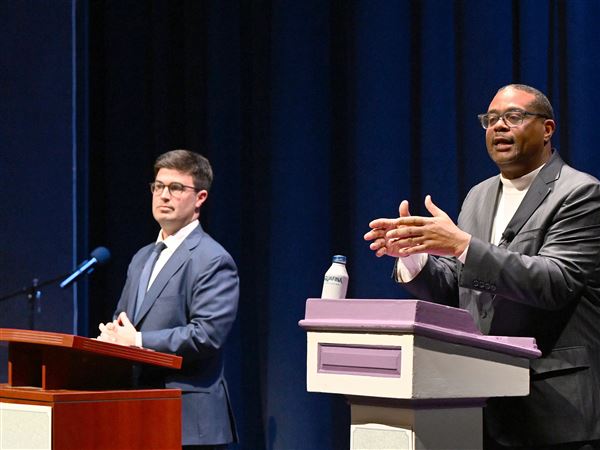It may not come as a surprise that the regulatory review of hospital mergers for years hinged on an economic theory involving the sale of such things as beer.
In fact, hospitals around the country used the so-called Elzinga-Hogarty test in successfully fending off government challenges of mergers in the 1990s. Hospitals appropriated the test that had been used to determine competitive markets for such things as coal and beer to define broad geographic markets for competing hospitals, therefore minimizing the impact of a proposed merger.
But by 2007 — long after the rapid rise of Pittsburgh health system UPMC through acquisitions of Montefiore, Passavant, St. Margaret’s and other hospitals — the theory had been discredited in regulatory matters involving health care.
Now, Elzinga-Hogarty has been replaced by an amalgam of court decisions, public input, pricing considerations and other factors that the Pennsylvania attorney general’s office is using to address antitrust concerns in UPMC’s planned acquisition of Jameson Health System, a merger originally announced two years ago.
If the two sides can agree on a way to protect health care consumers in Lawrence County from price spikes while assuring patient access to medical care, the merger could finally get the OK in the form of a consent decree.
Trying to preserving access to care
“Price — that’s the standard concern in antitrust cases,” said Martin Gaynor, professor of economics and health policy at Carnegie Mellon University and former Federal Trade Commission consultant. “If price goes up for health insurance, then company premiums go up. They just pass those costs on to the people who work there, so consumers are harmed by higher prices, even though it doesn’t come right out of their pockets.”
Jameson and officials in the attorney general’s office declined comment for this story. UPMC said it was still committed to the deal, but regulators are walking a fine line in balancing the prospect of higher health care costs with the need to preserve access to medical care for Lawrence County residents.
Jameson began looking for a partner in 2013 and UPMC was a natural candidate. The two hospital systems have had joint ventures in surgery and heart and cancer care since 1979.
And in September 2014, the health systems announced Jameson would be folded into UPMC Horizon Hospital in Greenville, Mercer County, giving UPMC control of the hospital market in Lawrence and adjoining Mercer and Venango counties.
Sweetening the deal was UPMC’s promise to invest $70 million in service and facility improvements at Jameson, plus help with physician recruitment — a chronic struggle for community hospitals in rural areas.
But the acquisition had stalled by May 2015 over antitrust issues raised by the attorney general’s office. At the time, state regulators said they wanted to make sure that the transaction wouldn’t spur price increases for consumers and employers or reduce access to medical services.
Jameson President and CEO Doug Danko said last year that the attorney general was concerned a significant number of New Castle-area patients would be referred for care to UPMC hospitals in Pittsburgh, expanding the hospital giant’s control of the Western Pennsylvania market. But, he said, internal Jameson studies had shown that local patients were more likely to go to Allegheny Health Network doctors.
Uncertainty about the UPMC deal prompted one of two obstetricians at Jameson to leave for another job. Unable to fill the positions vacated by the doctor and other unit staff members, Jameson stopped offering childbirth services in August 2015.
The attorney general’s office then asked Jameson to solicit bids from other health systems, but the result was the same: UPMC was identified as the best partner.
The shift toward consent decrees
What’s left now is hammering out a deal that preserves competition in the marketplace without risking the closure of Jameson, experts say.
“The easy solution is to prevent mergers, but do we know that this little hospital can survive on its own,” said Robert Berenson, a fellow at the Urban Institute, a Washington, D.C.-based think tank, who is not involved with the UPMC-Jameson merger. “It may be the best thing to happen, but that doesn’t mean you should be allowed to raise prices 100 percent.”
Several studies, including one by the Federal Trade Commission in 2008, have shown that hospital consolidation leads to higher costs for consumers as bigger systems use size in bargaining for higher reimbursement from insurers. Pennsylvania has responded to such concerns with consent decrees that guide future conduct of the merging institutions.
In a 2012 settlement, for example, the state attorney general reached a settlement in Danville, Pa.-based Geisinger Health System’s acquisition of struggling Bloomsburg Hospital that contained some far-reaching provisions for controlling hospital charges.
The attorney general said the merger would reduce the number of rival hospitals and physician employers, which would likely lead to higher consumer costs for health care.
Among the terms of the consent decree that allowed the deal to go through was one prohibiting Geisinger from extending its rates to Bloomsburg while allowing insurers to request an independent third party to review Bloomsburg’s future rate hikes to assure a “reasonable profit margin for similarly sized and well run community hospitals.”
Even as it tries to reach an agreement in Lawrence County, the state Attorney General has joined the FTC in protesting the proposed merger of Penn State Hershey Medical Center and PinnacleHealth System near Harrisburg, saying the deal would lead to reduced quality and higher costs for consumers.
”We have learned the hard way in Pittsburgh what happens when a health system has a large market share,” Attorney General Kathleen Kane said in December in announcing the action.
Meanwhile, the Elzinga-Hogarty theory was discredited as a tool in assessing hospital mergers by none other than co-author Kenneth Elzinga, an economics professor at the University of Virginia, at an FTC hearing in 2005 involving Illinois hospitals.
Mr. Elzinga testified that the markets for such things as coal and beer behaved differently than patients seeking medical care, ushering an end to the rule-bound era of hospital merger analysis and the start of Pennsylvania’s increasing reliance on consent decrees to preserve competition in the health care marketplace.
One hitch: antitrust experts say it isn’t yet known how well Pennsylvania’s consent decree strategy works.
Kris B. Mamula: kmamula@post-gazette.com or 412-263-1699
First Published: March 14, 2016, 4:00 a.m.















